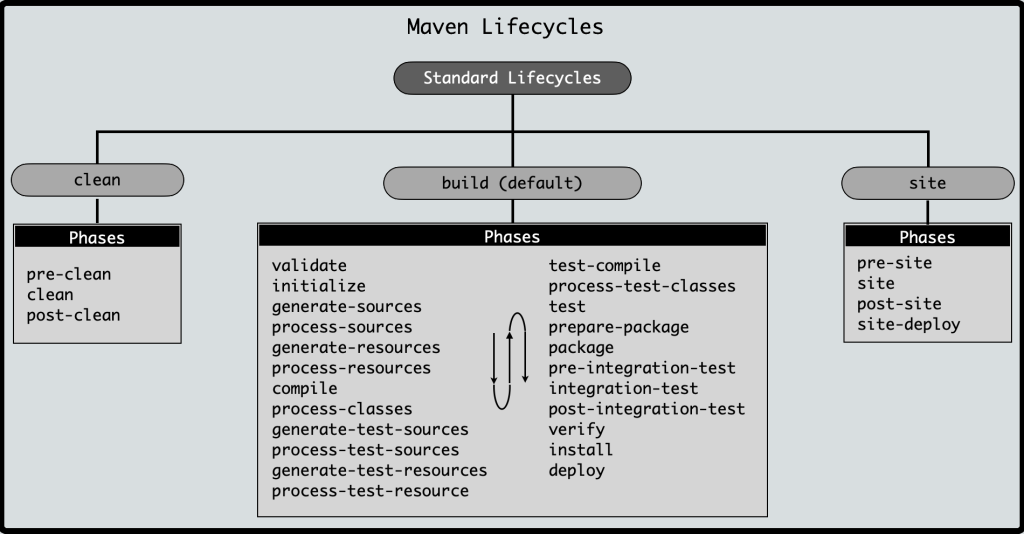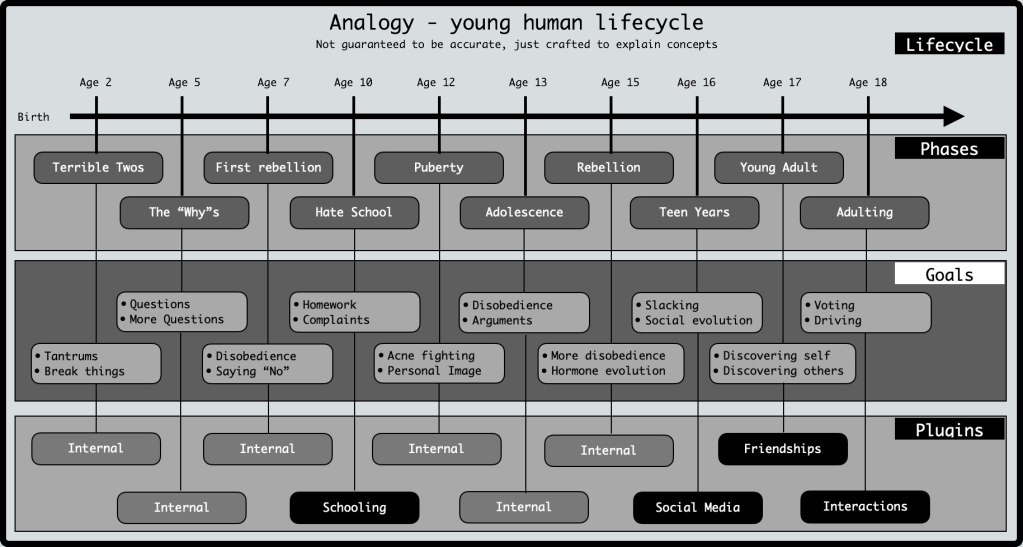Understanding Apache Maven (Part 4): Maven Lifecycle
- October 08, 2021
- 3999 Unique Views
- 5 min read
In Part 4 of the series, a walkthrough of the Maven lifecycles and executions is covered.
Apache Maven executions are tied to lifecycles. A lifecycle groups a sequence of activities. Maven provides three basic lifecycles for its standard build management. More lifecycles can be created as needed, though that is a rare need. There are three standard lifecycles provided by Maven.
Standard lifecycles
- clean – Intended for clean-up of any prior build-managed outputs and artifacts.
- default (build) – Intended for project build, test and deployment of artifacts.
- site – Intended for project site documentation.
What’s in a lifecycle?
A lifecycle is a collection of related activities pertaining to a specific type of build-management. Standard lifecycles include generation of build output artifacts, creation of a documentation site as well as cleaning any artifacts produced from a prior execution.
Lifecycles in Maven comprise of phases. Each standard lifecycle is made up of a few phases. Maven commands are typically executions of phases. More on this in a little bit.
Phases are sequentially executed.
Invoking a phase implies all prior phases in that lifecycle are executed.

Exploring phases
Phases are executable blocks. Phases follow an ordered sequence within a given lifecycle. Reiterating what was already mentioned, invoking a phase implies invoking all phases before it in the lifecycle.
Goals are bound to phases.
Goals – units of work
Goals are units of work (tasks). Goals are attached to a phase and this is called a binding. A goal performs a task that is considered relevant for the given lifecycle and phase. Maven provides some built in goals. Goals are defined in plugins.
Binding Goals
Brief digression: Maven outputs are controlled by packaging. Packaging defines the type of output expected when executing a Maven POM. A POM includes the packaging as a top level element. Default packaging is a
jar.
As mentioned earlier, goals are bound to phases. Every packaging comes with a predefined set of goals bound to phases of the default lifecycle.
However, for some goals, there is a clear phase that fully corresponds to their execution. Such goals do not have a need for being linked to a packaging.
Some goals may not be bound to anything and can be invoked directly without a phase-binding.
Plugins – definers of goals
Plugins are Maven’s way of defining goals and providing connectors for the goals to phases. Plugins are developed as MOJOs (Maven’s plain Old Java Objects). The plugins define goals and supply logic to deliver the goals. Goals are usually bound to phases in either the Maven built-in configurations or the project POM file.
Binding Goals to Phases
An example of binding for the Clean lifecycle (very confusing nomenclature, but worth reading)
Lifecycle clean : Phase clean
Plugin maven-clean-plugin (prefix clean) : Goal clean
The clean:clean (plugin:goal) is bound to the clean phase. Thus, executing the clean phase will trigger the run of the maven-clean-pluginwhich will look for and execute the clean goal.
Another example of binding, for the Site Lifecycle (site-deploy phase)
Lifecycle site : Phase site-deploy
Plugin maven-site-plugin (prefix site) : Goal site-deploy
The site:site-deploy (plugin:goal) is bound to the site-deploy phase. Thus, executing the site-deploy phase will trigger the run of the maven-site-plugin which will look for and execute the site-deploy goal.
Maven offers a set of bundled plugins and these plugins have a defined set of goals. Plugins can also be external to the Maven distribution and can be built by other users of Maven. The standard lifecycle phases of clean and site have default phases and bindings defined. This is done in the maven-core META-INF/plexus/components.xml, if you’re curious to dig through the details. Link to GitHub source: https://github.com/apache/maven/blob/maven-3.6.3/maven-core/src/main/resources/META-INF/plexus/components.xml.
It is usually rare to bind goals, by default, to phases prefixed with pre and post, but those are valid phases and goals can be bound to such.
Lifecycle
Associated plugin (as of Maven 3.6.3):clean
Default Phase:cleanorg.apache.maven.plugins:maven-clean-plugin:2.5 : clean
The default phase implies that if the lifecycle is invoked without a phase, the default phase (and any phases prior to it) will be executed. In this case, invoking the lifecycle will invoke both the pre-clean and clean phases.
The plugin coordinates follow the standard maven GAV coordinate system that was covered in Part 3 of this series. The content after the colon separator after the plugin coordinates is to point to the goal in the plugin.
Command line:mvn clean
The site lifecycle has two default phases, site and site-deploy. A dissection of the site-deploy default phase is shared below.
Lifecycle
Associated plugin (for site-deploy and as of Maven 3.6.3):site
Default Phase(s)siteandsite-deployorg.apache.maven.plugins:maven-site-plugin:3.3:deploy
Invoking the default phase of site-deploy will cause all phases (pre-site, site, post-site and site-deploy) to be executed.
The plugin coordinates follow the standard maven GAV coordinate system that was covered in Part 3 of this series. The content after the colon separator after the plugin coordinates is to point to the goal in the plugin.
Command line:mvn site-deploy
The default lifecycle is unique. The overarching focus of the default lifecycle is to verify, compile, generate sources/resources, test, install and deploy the project code. It is thus not practical to setup defaults in this lifecycle, to a phase. The bindings are set at a different level called packaging.
A good listing for site and clean phases’ bindings can be found at: https://maven.apache.org/ref/3.6.3/maven-core/lifecycles.html.
Binding Goals Using Packaging
Packages – descriptors of outputs
Packages are a core element in the Maven POM and define the type of output produced by building the POM. It is possible to tie goals to the package element. Valid package names include: jar, war, ear, pom etc. Each package has some unique goals and thus goals are bound to these package names.
Binding Goals to Packages
Maven allows binding goals to packages. The default lifecycle is a great example and the bindings can be located at the maven-core META-INF/plexus/default-bindings.xml. Link to GitHub source: https://github.com/apache/maven/blob/maven-3.6.3/maven-core/src/main/resources/META-INF/plexus/default-bindings.xml
A few examples of bindings:
Package bindings for ejb, ejb3, jar, war, par and rar packages:
Phaseplugin:goalprocess-resourcesresources:resourcescompilecompiler:compileprocess-test-resourcesresources:testResourcestest-compilecompiler:testCompiletestsurefire:testpackageejb:ejb or ejb3:ejb3 or jar:jar or par:par or rar:rar or war:warinstallinstall:installdeploydeploy:deploy
jar,war,rar,ejb,ejb3,parpackages
Package bindings for pom package:
Phaseplugin:goalpackage installinstall:installdeploydeploy:deploy
pompackage
A good listing for the default lifecycle bindings can be found at: https://maven.apache.org/ref/3.6.3/maven-core/default-bindings.html.
Summary
This blog was lengthy !
A lot of material was covered. In summary:
- Maven provides standard lifecycles.
- Lifecycles are a collection of phases.
- Logic to execute specific actions is developed in plugins.
- Plugins are MOJOs (Maven plain Old Java Objects)
- Plugins define and carve out tasks called goals.
- A plugin can define several goals.
- Plugin goals are bound to parts of lifecycle and executed.
- The goals can be bound at either to a phase or based on packaging type of the POM.
- Execution of a Maven lifecycle implies execution of goals bound to parts of the lifecycle.
- Maven commands invoke a goal .
A deeper dive into plugin-prefixes can be found at: https://maven.apache.org/guides/introduction/introduction-to-plugin-prefix-mapping.html.
Convention standards for plugin prefixes:
maven-${prefix}-plugin– for official plugins maintained by the Apache Maven team itself (you must not use this naming pattern for your plugin, more on this in a future blog on plugin development)${prefix}-maven-plugin– for plugins from other sources
Something Something – Personal Learning
Here is a very crude and unscientific pictorial of the my understanding of lifecycles, phases, goals and plugins. This is not meant to be accurate in terms of either human lifecycles or in explaining maven’s lifecycles. This picture is absolutely a personal means of illustrating how I went about learning these concepts.

That’s a wrap on this article. Have fun with Maven!
Don’t Forget to Share This Post!






Comments (0)
No comments yet. Be the first.